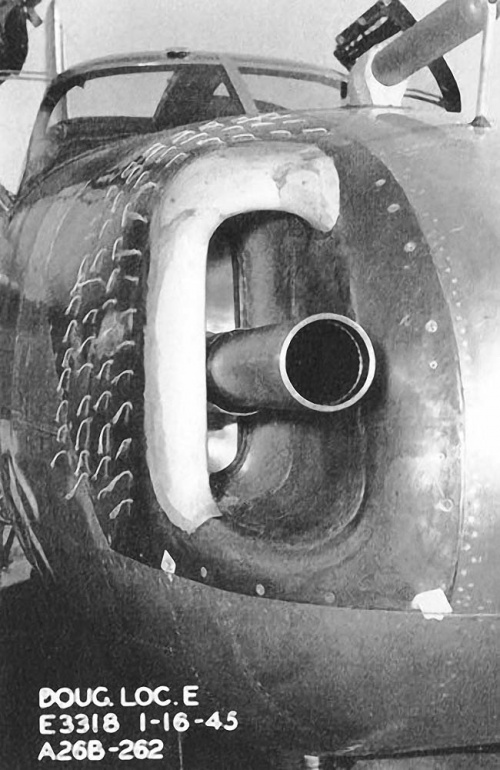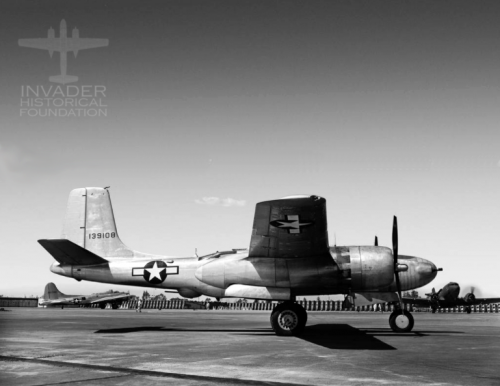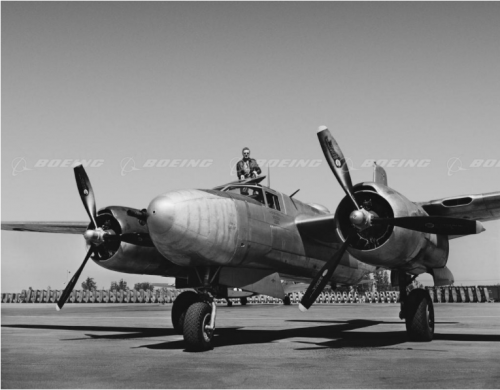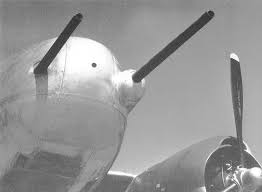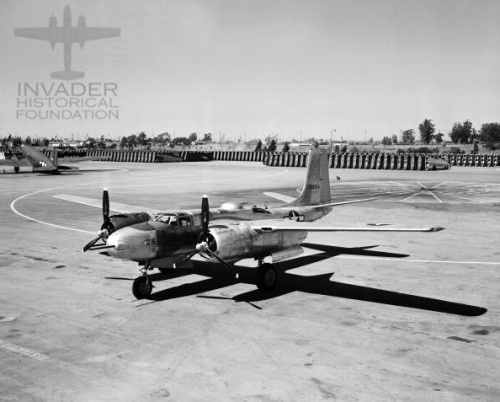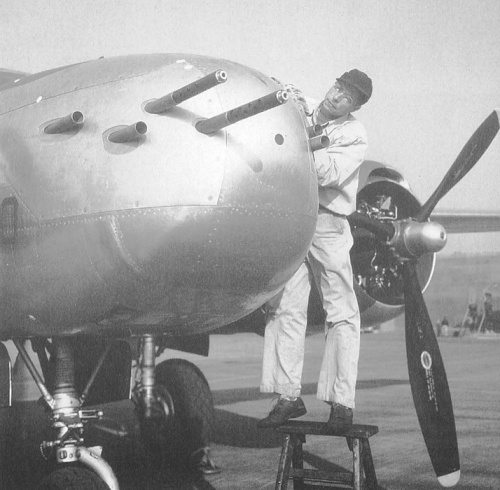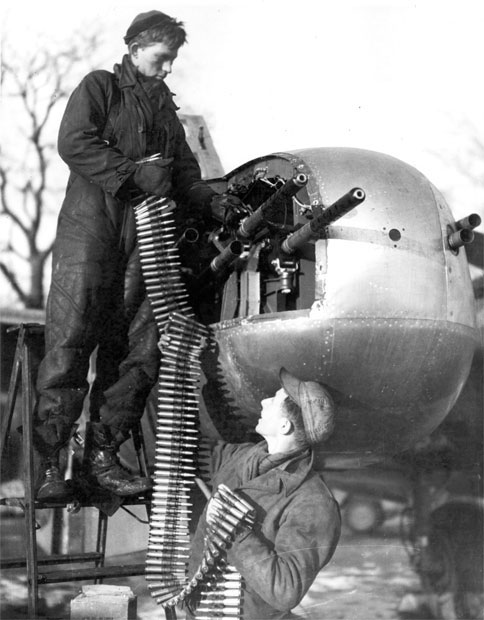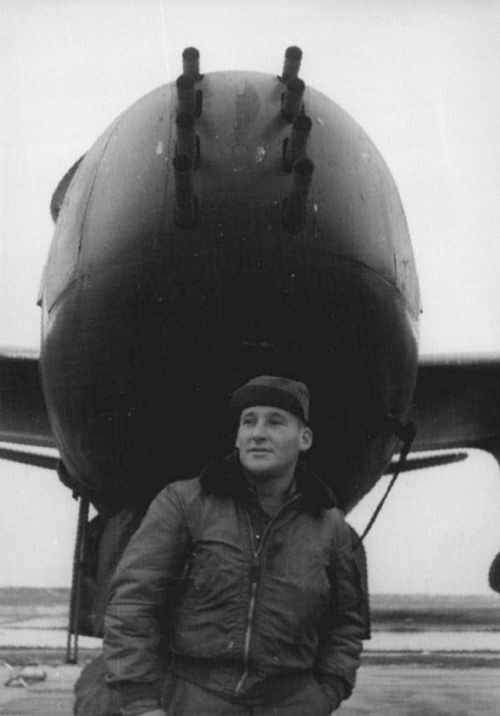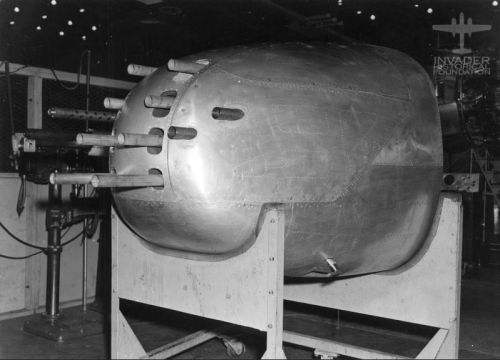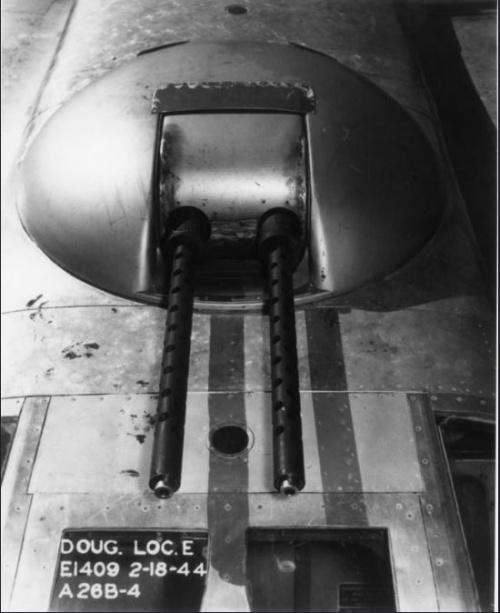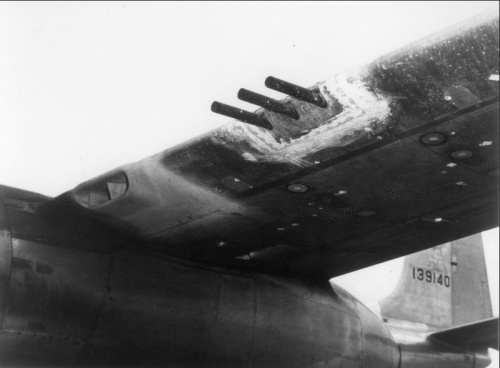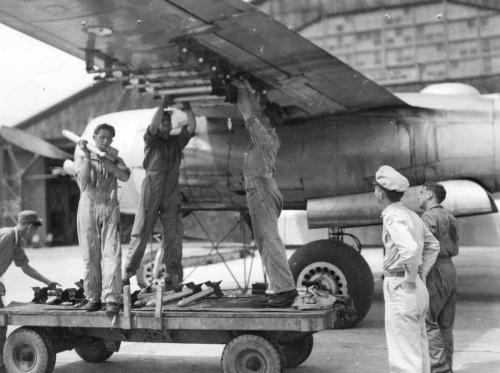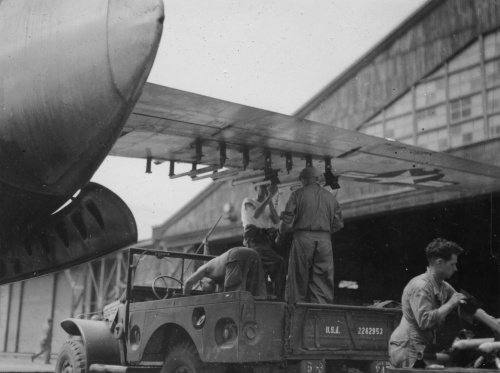Invader Weapons: Difference between revisions
(→6-Gun) |
|||
| Line 45: | Line 45: | ||
By production block 15 the "general purpose" nose was put into place. It could, as the mission required, but swapped out for a different nose in the field. The standard configuration for the general purpose nose was a 6x .50 caliber machine gun arrangement. This gun configuration was the most prolific version produced. <br/> | By production block 15 the "general purpose" nose was put into place. It could, as the mission required, but swapped out for a different nose in the field. The standard configuration for the general purpose nose was a 6x .50 caliber machine gun arrangement. This gun configuration was the most prolific version produced. <br/> | ||
[[File:A-26 Six Gun Nose.jpg|500px|center]] | [[File:A-26 Six Gun Nose.jpg|500px|center]] | ||
Two unknown crew members loading a WW2 hard-nose Invader's Browning M-2 Machine Guns. | |||
[[File:Gun Loading.jpg|500px|center]] | |||
====8-Gun==== | ====8-Gun==== | ||
Revision as of 04:27, 7 September 2018
The A-26B Invader had an outstanding armament load-out. In this section we'll cover all of the various ways this plane could be armed and equipped.
Nose Guns
The Invader was capable of being equipped with a wide variety of nose-mounted armament.
Cannons
75MM
The first production Invaders were built with a 75mm cannon in the nose. A very small number of Invaders were actually produced at the factory with this configuration. Production block 1 (5 planes) and block 5 (15 planes) were built with this nose. By production block 15, the nose was altered to be a swappable "general purpose" nose. Officially there are no reports of this cannon being used in combat. Unofficially, I've heard unverified tales of at least one plane in Korea that was equipped with such a nose specifically to combat trains hiding in tunnels.
Here you can see the wooden mock up for the original 75mm cannon placement. This photo has given rise to the idea that the 75mm cannon was deployed with 2x .50 caliber machine guns. However, this doesn't seem to be the case.
This is an early housing prototype that allowed the gun to move up or down by 15 degrees. Ultimately, this design was not used.
Here is the 75mm cannon on the XA-26B prototype Invader.
And here is one of the earliest production model invaders to come equipped with such a nose.
This photo is perhaps the most telling of what was eventually installed on the production model units. This early model Invader is equipped with the 75mm cannon, but it is lacking the 2x .50 caliber machine guns from the wooden mockup. This is one of the first 20 Invaders produced, and after those first 20 came off the line, the default nose armament was changed to machine guns. Although the wooden mockup and illustrations suggest 2x .50 caliber machine guns installed alongside the 75mm cannon, there are no known photographs of this configuration actually being produced. The small hole in the center of the nose in the image below was for gunsight to allow the cannon to be aimed.
Here is another production model invader with the 75mm cannon. Note that this plane is a different plane than the one posted above. And, like that one, this one is also lacking the 2x .50 caliber machine guns shown in the wooden mockup.
75MM & 37MM
Douglas experimented with several different cannon combinations. One of the variants that they produced in very limited quantities was a 75MM cannon paired with a 37MM cannon.
Here is that same plane from the side.
37MM & 37MM
One of the nose configurations that was available was twin 37MM cannons. This configuration was tested on at least 1 production model variant.
This photo shows a production model Invader equipped with twin 37MM cannons.
Machine Guns
The Invader featured many different configurations of machine guns during its service lifetime. With a single burst of the all machine guns, the entire aircraft would buffet violently rearward, a consideration for the crew to keep in mind in terms of their own safety. In total, at maximum configuration, a given A-26 could be equipped with as many as 22x .50 caliber machine guns with up to 6,000 rounds of ammunition.
6-Gun
By production block 15 the "general purpose" nose was put into place. It could, as the mission required, but swapped out for a different nose in the field. The standard configuration for the general purpose nose was a 6x .50 caliber machine gun arrangement. This gun configuration was the most prolific version produced.
Two unknown crew members loading a WW2 hard-nose Invader's Browning M-2 Machine Guns.
8-Gun
Later production B-26Bs featured a total of 8x .50 caliber nose-mounted machine guns. This assembly allowed the Invader to make devastating strafing sweeps on enemy ground targets with usually destructive results, combining the concentrated power of the heavy caliber machine guns into one focal burst. By the time this configuration made it into deployment World War II was almost over and this version saw little use in combat. It was, however, heavily used in the Korean War.
14-Gun
As World War II progressed Douglas continued to find ways to increase firepower. They experimented with an arrangement that would have allowed 14x .50 caliber machine guns to be fitted in the nose, however, this version never made it into production. Although this nose was being tested, it is unclear how it would be received in the field. Plane crews reported that firing all 8 of the 8-gun nose machine guns resulted in smoke filling the cockpit. To combat this, many crews would disengage or remove two of the guns, which cut down on the smoke and allowed the plane to have a couple of spares if they needed them.
Turrets
In addition to the nose armament, two .50 caliber machine guns were held in a dorsal turret, and two more .50 caliber guns in the ventral turret. Invaders that were supposed to go to the 5th Air Force in the Pacific had the ventral turret removed in favor of an additional 125-gallon fuel tank. The upper turret is pictured below. The lower turret looks identical.
Wing Guns
Gun Pods
Invaders could also be equipped with underwing gun pods. Each pod carried 2x .50 caliber machine guns, allowing the plane to carry an additional 8 machine guns, in addition to the nose guns.
Wing Guns
Later production models discontinued the use of the underwing gun pods in favor of 3 internally mounted .50 caliber machine guns in each wing's leading edge (for a total of six), along with blister mounts on the fuselage sides - all concentrated in a forward-firing position.
Bombs
The Douglas Invader's lethality was further accented by the option of carrying between 4,000 and 8,000lbs of internal and external ordnance in the form of drop bombs or rockets. In fact, Invaders were known to be able to carry greater bomb-loads than the larger Boeing B-17 Flying Fortresses. Endurance could be extended with the addition of 165-gallon underwing drop tanks, increasing the aircraft's range by up to 300 miles.
Rockets
The Invader could carry between 8 and 14x 5" rockets held externally on underwing pylons. They could carry as many as 16 rockets if they traded out the fuel drop tanks or wing mounted bombs.
Invader 44-34538 "Feeding Frenzy" showing an array of missiles on the wings.
A 13th Bomb Squadron Invader (Tail Letter W) is being equipped with Rockets prior to a mission at Yokota Air Base, Japan in July, 1948.
Torpedoes
According to the Official Pilot Training Manual for the A-26 Invader, published by the Army Air Force Office of Flying Safety, the Invader could carry 2 standard torpedoes in the internal bomb bay, released by the same button that drops the bombs. Although capable of this feature, it was never used in combat. The majority of the Invaders that were earmarked for the Navy were cancelled due to World War 2 ending. When the Navy did acquire Invaders in the post-war period they were used as utility planes for towing targets. The following two illustrations show a torpedo coming from the Invader comes directly from the Pilot Manual.
Page 61 of the Pilot Training Manual describes the Invader's torpedo capabilities:
"A single-station panel is provided between the forward and aft bomb bays to carry two torpedoes. The A-26 is an extremely versatile offensive weapon. It has tremendous strafing firepower. It can bomb from various altitudes down to skip bombing, and it can launch torpedoes. But remember, although there are 24 bomb stations altogether, only 16 of those stations can be used at any one time."
Further instructions are found on page 62:
"Torpedo Stations: Two torpedoes may be loaded as alternate armament. When torpedoes are carried, the bomb rack panels and the removable portion of the front bomb bay rail are removed. The bomb bay doors must be left open. Release your torpedoes electrically by the bomb release button with your torpedo circuit switch ON. Salvo your torpedoes manually with the bomb control salvo lever (or switch in some models)."
Although it was never used in combat, the US Navy did experiment with wing-mounted torpedoes on their Invaders. This torpedo has unusual fins and a strange cowling on the bottom. It appears to be some kind of experimental version, but the story behind it is not known to us at this time.

